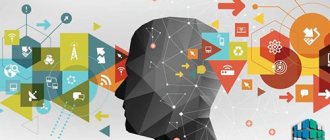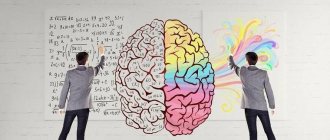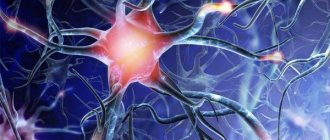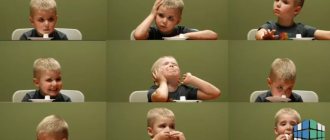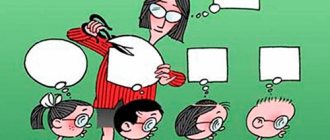Every person living on the planet certainly asks questions about his development at a certain period of his life, but unfortunately, most often the physical aspects of human health and strength come to the fore, but the development of mental capabilities is no less important, and sometimes can play a decisive role in the fate of the individual.
Human brain activity has not been fully studied and definitely consists of many processes that require an individual approach and their own methods of training and stimulation. However, at this stage we will consider such a broad concept as thinking and those effective ways of influencing it, which will lead to the formation of effective thinking in its various forms and directions.
As it is now
How regular learning occurs, especially in new areas.
Learning model.
First, you are bombarded with a story with a bunch of incomprehensible terms. There is not even a hope of understanding; you are trying to remember with the opportunity to “comprehend it later.” But “comprehension later” does not occur immediately, because there is no understanding of the entire mechanism of comprehension.
Then, during your training, you come across a bunch of evidence about what exactly these or other terms mean and “how everything works in general.” In fact, you wander around the area you are mastering from corner to corner, almost randomly gaining an understanding of certain things.
You can, of course, ask questions to specialists. But an additional difficulty is to distinguish a deeply understanding specialist from a person producing a set of “cached thoughts.”
As a result, understanding is monstrously far from complete, and there is no talk of application. This is where the legs of the saying “forget everything you were taught” grow from. This is usually said when a young specialist gets his first job.
Of course, this is an exaggerated picture. In reality, this is a certain state between “total understanding” and “total misunderstanding.”
Edward de Bono's Six Thinking Hats Method
Among other theories of creativity, the method of lateral thinking specialist Edward de Bono is distinguished by its youth. The Six Thinking Hats was first published in 1985, introducing the public to a technique for organizing thinking and a way to solve creative problems and disputes. Today, this technique has become popular enough to gain both its fans and opponents. Perhaps philosophers would consider it necessary in this situation to joke about the hermeneutic circle, saying that the methodology that defends different views on things is itself evaluated differently. But without irony, we will try to understand the essence of the 6 hats technique, its pros and cons, as well as its application possibilities. Read more…
10
Key idea
“What I can’t recreate, I don’t understand.” Richard Feynman.
Productive thinking is based on a very simple idea: understanding should pay off.
Payback is when understanding gives you the ability to predict the outcome of an action with an entity.
For example, understanding the fragility of a crystal wine glass allows you to predict what will happen if you drop this wine glass from a height of 1.5 meters onto a concrete floor.
Understanding the elasticity of a rubber ball allows you to predict what will happen if it is dropped from the same height.
Mechanism of the thought process
Definition 4
The thought process is a conscious process based on concepts and images.
The thought process evaluates the situation. It ends when it achieves some results. Those. a problem is set, and the search for its solution begins.
Solving the problem has four stages:
- preparation;
- search for a solution;
- inspiration;
- checking the solution found.
Algorithm for the thought process of solving a problem:
- Motivation.
- Analysis of the problem (what is given, what remains to be found, etc.).
- Finding a solution:
- search based on one well-known algorithm (relates to reproductive thinking);
- search based on choosing the optimal option from a variety of known algorithms;
- solution based on mixing elements from different algorithms;
- the search for a new solution (related to creative thinking) is based on: in-depth logic of reasoning (analysis, comparison, synthesis, etc.);
- analogies;
- heuristic techniques;
- empirical method.
In case of failure, disappointment occurs and a switch to another type of activity occurs. In other words, a “period of incubation rest” arises, where new ideas are generated, inspiration and insight appear (instantly finding a solution).
Factors that influence insight:
- strong passion for the problem;
- belief in success;
- experience, a large amount of information about the problem;
- high associative brain activity (during sleep, during illness, etc.).
- Proof of the found idea using logic.
- Implementation of the solution.
- Checking the solution found.
- Correction if necessary (in this case you need to return to the second stage).
Thinking technique
Consists of three simple steps.
- We highlight key statements.
- We make them pay for themselves.
- We build a chain (model) from them.
The wording is simple, but contains a number of things that are not obvious. You need to figure out what key statements and how to highlight them in speech. And also how to make them pay off . This is what we will do. And to do this, you need to figure out what speech is in general?
Harson's productive thinking model
Creativity is essential to solving any problem. If you are not creative and more logical, you will not be able to evaluate the problem from different points of view and come up with an unusual and simple solution. And if you combine critical and creative thinking, your effectiveness increases significantly. Harson's productive thinking model will help you do this. This model encourages using both sides of the brain and alternating between creative thinking and critical and logical thinking. This means that you can look at a problem from different angles and find the best solutions. Read more…
8
Speech structure
From the point of view of effective thinking, speech consists of two main parts.
- The main course is a chain of statements that contains the main meaning.
- Side dish - additional information that does not change the main meaning in any way, serves to captivate the audience and create the context of the “story”. In general, what is now called storytelling.
Very often speech looks like a huge station pie. It's big on the outside, but when you start eating it, you find that it takes quite a while to get to the filling.
After understanding this structure, it is important to separate the two types of perception. And consciously make a choice which perception to include now, and what the result will be after that.
The first type of perception is that we eat a side dish mixed with the main dish and enjoy the taste.
Pros - it is easier to immerse yourself in history, receive sensual - emotional pleasure. Cons - a skillful speaker will easily lead you to any conclusions. Well, if the content is completely truthful, then the quality of its development and understanding will be much worse. Don't rush to object. Try to apply, compare and see for yourself.
The second type of perception is that we strictly cut off the side dish and conduct a strict analysis of the main dish.
Pros - understanding becomes as great as possible. There is a clear understanding of what questions need to be asked in order to make the picture as clear as possible. It is these questions that will easily expose a charlatan in one case, or will give the impression of sincere interest to a good specialist in another.
After the work done, the reward will be a feeling of satisfaction.
Cons: You won’t be able to immerse yourself in the story and relax. If the subject of the conversation is complex, then you can get seriously tired.
Two Ways of Thinking by Carol Dweck
In 2007, American psychologist Carol Dweck published a book called Mindset, where she argued that intelligence, talent and education do not necessarily lead a person to success. The main criterion is the way of thinking and how a person copes with life’s problems, difficulties and challenges. In this article, we'll explore what Carol Dweck's mindset is and how a fixed mindset can harm you when developing it will help you achieve your goals, increase self-motivation, and increase productivity. Read more…
5
Statement
“I slowed down - at the first place I came across - and carefully read the next sentence. I don’t remember it exactly, but it was very similar to this: “An individual member of a social community often receives information through visual, symbolic channels.” I turned this sentence this way and that and finally translated it into normal language. Do you know what it meant? “People are reading.” Richard Feynman.
In this part, we will finally begin to swing a sword, shred any narrative as we need and build a harvester of genius into our brains (hyperbole :-).
It is important to separate key information from accompanying information. Contents from packaging, wheat from chaff. To do this, let’s figure out what a statement is. Please note that I mean a statement within the framework of my system, and not, say, within the framework of traditional logic.
A statement is a sentence simplified to the form:
" essence - action - essence ."
Examples:
Cows - give - milk .
I play guitar .
Children love sweets .
Vitamins are useful.
The trick is to not forget that in Russian the verb “to appear” is often omitted. For example, the sentence “The flower is yellow” = “The flower is yellow.”
By default, few people provide information in this form and think in such categories. Therefore, we use techniques.
More details about the concepts
It is impossible to understand this issue in detail without finding out the definitions of all terms. Thinking is the process of processing information data and bringing it to a specific conclusion. This ability gave rise to the emergence of speech, which we use to communicate with each other. People come to reflection in order to resolve all troubles and problems, explore the world around them, find out relationships and patterns. By thinking, a person creates innovations, makes scientific discoveries and finds himself in art. Without a mental component, we would be similar to ordinary animals that act within the framework of their instincts.
Forms of thinking are the result of thought and mental processes that manifest themselves in a specific situation, which allows one to understand the essence of phenomena and objects, determine the relationships of objects and notice general signs. There are only three varieties, which I will discuss in detail below.
Reception. Simplification.
Simply put, throw away everything unnecessary. You can do it in two ways. The first is to break the sentence into several statements. The second is to make one statement out of a long sentence.
Examples:
Original proposal:
“It would be good to be able to notice situations in which you see things not as they are, but as you want to see.”
Result:
You have want .
Reality is replaced by what is desired .
You want to notice it.
One sentence was divided into 3 simple statements. Why 3? Because an attempt to make only one statement leads to the fact that the rest must be implied or conjectured. Implicit means not explicit. But with the implicit it is more difficult to work and it is easier to make mistakes.
Or another example:
“Julia Galef called motivation and the ability to see things as they really are the “scout mindset” and wrote a book about it, “The Scout Mindset.”
Simplified to:
Seeing reality is the intelligence of an intelligence officer .
Why is that? Because every narrative has a purpose. In this case, Julia in her book talks about certain thinking techniques. Do last names, book titles, dates have anything to do with how these techniques work? Obviously not. Therefore, we take out a saber and, with a dashing whistle, without regret, we cut it all off into the trash.
How to develop children's thinking: methods
There are several basic techniques for expanding a child’s horizons:
- Talk to him more, explain even the most basic things. Use in your speech many unfamiliar words, epithets, and phraseological units. Pause, change the pace and length of your sentences.
- Make a sharp transition from one topic to another, or describe in great detail every little detail (description of a song, poetry or weather) in all colors.
- Walk through places unfamiliar to him, pay attention to everything (tree, bush, flowers, landmark, animals, birds).
- Listen together to music of a wide variety of styles from classical to rock.
- View images in books or family photos.
Why is all this needed?
Firstly, we can hold a limited number of thoughts and ideas in our heads. And if you try to perceive everything , you will lose the main thing.
Secondly, we will need to work with statements. The simpler the statements, the easier and faster it is to work with them. The faster we work with them, the more operations we can do per unit of time. The more operations there are, the better we understand the model built in our heads (the chain of key statements).
Classification of human thought process
Structure of thinking:
- visually effective (0-3 years);
- visual-figurative (3-6 years);
- verbal-logical and abstract (10-18 years).
Let's look at each of them.
Visual-real thinking is based on the direct perception of objects, the transformation of which occurs at the moment of interaction with objects.
Visual-figurative thinking is based on ideas and images. Those. a person imagines situations and changes in them what he ultimately wants to receive from his activities, i.e. he transforms the situation.
Verbal-logical thinking is based on the logic of operations with concepts.
Analogy
Metaphorically, we can imagine that we are building a mechanism consisting of gears. By gear we mean essence. A very similar thing (from a slightly different direction) is described here as gearing.
The first question we ask ourselves is: “How can we move (twist, move) the gear?
Second : “What will happen to the gear itself if we twist/move it like that?”
Third : “What will happen to the nearby gears if we twist/move this one?”
If we move away from metaphor to reality, then we take the essence and ask ourselves - What properties does it have? As soon as we find any property, we begin to change it and ask ourselves: “What will happen?”
Changing the property is what I mean by “twist/twist/move”. The answer to the second and third questions is what I mean by a forecast. Let's move on to real examples.
What are the forms of thinking based on logic: examples
Following the logical structure of mental activity, the following processes are put forward:
- comparison;
- analysis;
- abstraction;
- synthesis;
- generalization.
The comparative operation is based on determining the similarities and differences between phenomena. The result is a classification, which serves as the primary stage of theoretical understanding.
Face-to-face consultation
What are the features and advantages of face-to-face consultation?
Find out more
Skype consultation
What are the features and benefits of Skype consultations?
Find out more
Analysis is the procedure of dividing one significant object into various parts or characteristics, followed by comparison.
Synthesis - with its help you can mentally create a complex object from analytical components.
Abstraction – highlights significant properties and connections of phenomena and abstracts from insignificant ones. This is a process of detailed study, as a result of the research, concepts are formed.
Generalization is the ordering of objects according to common and essential characteristics.
Mental operations occur on the basis of logical ones, but this does not always work as a mechanism in which only reason and logic function. Very often emotions interfere with this process and completely change it. Since the emotional component has the ability to change and stimulate mental activity. Feelings tend to impart tension, goal-seeking, and ambition. Without emotions, productivity is reduced to zero, just as without logic, knowledge and skills.
We make it worthwhile.
Payback is the ability to make accurate forecasts. A forecast is the answer to the question: “What will happen if you do this?”
Payback is possible only if we understand the essence of the phenomenon. And here we come across the main trap and at the same time a wild boost to thinking productivity. First I will formulate it, then I will explain it with examples.
Trap: very often understanding the essence is replaced by understanding the words.
Implications: Understanding words does not allow for accurate predictions.
An example of payback and accurate forecasts. There is a suggestion:
There is a wooden cube on the floor.
We have an entity - a small wooden cube. We begin to twist/twist. The cube has a property - position in space. If we change this property, we get the following questions:
“What happens if the cube is placed on the floor on one of its faces?”
“What happens if the cube is placed on the floor on its edge?”
Obviously, we can answer these questions accurately. In the first case, the cube will not move at all. In the second, the cube will fall on one of the faces and then stop moving.
An example of understanding words without understanding the meaning. There is a suggestion:
A note is a graphic designation of sound.
There is an essence - a note. It would seem that everything is clear. Since a note is a sound, a note has the same properties as a sound, such as pitch. We change this property and get the questions:
“And if the sound is made higher/lower by a few hertz, will it still be a note?
“Is every sound a note?”
“If not every sound is a note, then what distinguishes a note from a non-note?”
“How many notes are there?”
“Why so many?”
If you can answer these questions, congratulations, you have a real understanding of the essence of “note.” If not, then that's okay too. Most people mistake understanding words for understanding meaning. Indeed, from the point of view of understanding words, the sentence about the note is absolutely clear, not a single unfamiliar word.
That is, we take an entity and begin to change its properties. Twist and turn this way and that. If we understand what will happen, then we understand the essence well. If we don’t understand, then understanding is replaced by the feeling that the word is familiar to us.
Functions and processes of thinking
Any type of thinking implements a certain set of processes that provide knowledge of the world around us.
:
- Comparison – comparison of objects and phenomena, highlighting their similarities and differences;
- Analysis – dividing an object or phenomenon into components;
- Synthesis is the opposite process to analysis, in which a whole is reconstructed from individual elements by establishing connections and relationships;
- Abstraction – highlighting one distinctive property of an object while ignoring all other, less significant ones;
- Generalization – discarding individual features to preserve and comprehend common ones, establishing significant connections.
At the same time, a small child needs to carry out these actions literally: disassemble, put objects, arrange them according to certain characteristics. It is enough for an adult to mentally imagine all these actions.
According to their functions, types of thinking in psychology are divided into reproductive, productive and creative. The first type is repetition of learned rules according to a given algorithm; This is how, for example, typical problems in textbooks are solved. Here, thought processes are aimed not at obtaining new knowledge, but at consolidating existing material. The second type is productive thinking, in which a person goes beyond existing knowledge and receives some new information; Moreover, they are new only for a given individual, but not for humanity. If the information obtained in this way is new for humanity, then the third type is involved here - creative thinking. In this case, thought processes acquire special complexity and structure.
Visual-figurative thinking is subject to a single algorithm. First, a person gives one judgment, then adds another to it, and on their basis makes a third judgment - a conclusion. It is the goal of thought processes.
We are building a mental machine.
The construction itself is as follows:
- We construct the first statement (verbally, cutting off the unnecessary).
- In the statement, we check both the essence and the action for payback. If there is no payback, we ask questions and look for answers.
- We hold entities and actions in the imagination in the form of images.
- Let's add the following statement.
- We are looking for with the help of what action or entity the second statement is linked to the first. Sometimes this is stated explicitly, sometimes it is not stated at all. If it is not indicated, but is, as it were, “implied,” then one must make the implied statement a new statement and explicitly turn the gears that make it up.
- Making the second statement pay off.
- We add the essence and action of the second statement in the form of images to the picture.
- We are trying to twist/change the resulting coupling.
- Repeat steps 4-8 for each new statement.
As a result, in our imagination we will have a model, each element that we understand thoroughly. This means that the model turns into a single mechanism, which, in turn, we can change as we want or use it as a tool anywhere.
It looks cumbersome, but in reality many steps can be done very quickly. And after you get the hang of it, you can almost instantly distinguish payable entities/actions from non-payoff ones.
Main mistakes:
“They wasted a lot of time memorizing things like that when they could have been found and viewed in fifteen minutes.” Richard Feynman.
- Skip any entities/actions because they seem obvious to you. They may be obvious in other contexts. But it is not a fact that this will be obvious. Also, their influence/coupling with neighboring entities/actions may not be very obvious.
- To be lazy about twisting/twirling entities and actions. Understanding is never built through memorization. Only through interaction with entities and actions.
Types of thinking in psychology
There are several types of thinking in psychology.
All of them represent, as it were, different levels of representation of reality, different levels of abstraction
:
- Visual-effective thinking
. This is the primary level of understanding reality. In this case, thought processes are not yet separated from actions. It’s as if a person “thinks with his hands.” This type of thinking is predominant in children under three years of age. Thus, the child compares objects by placing them next to each other; synthesizes and analyzes, building a “house” from cubes and breaking toys; generalizes and classifies, arranging cubes by color, shape and size. In adults, such thinking does not disappear, but only fades into the background; it is used in cases where it is not possible to accurately predict events: when mastering unfamiliar equipment, rearranging furniture, etc. - Visual-figurative thinking
. This is a higher level of understanding of reality. Here, thought processes are ahead of actions, and not vice versa, as was the case in the previous case. To imagine an object and characterize its properties, a person no longer needs to touch it with his hands. This kind of thinking prevails in a child between four and seven years old. In adults, it manifests itself when, for example, they are planning an apartment renovation: a person can already imagine in advance what the room will look like, what color the wallpaper and ceiling will be, etc. - Verbal and logical thinking
. These are completely abstract thought processes that operate with concepts and logical constructs; such constructions sometimes may not have a visual image at all - such are, say, concepts like “honesty”, “cost”, etc. With the help of such thinking, a person determines the general patterns of various natural phenomena and generalizes visual material. It is clear that such thinking cannot be accessible to a small child, since at an early age a person has not yet accumulated a sufficient amount of figurative material.
Development of abstract logical thinking
Logical thinking is considered the highest form of the thought process, although this can be argued, since creativity is not associated with it, but with imaginative thinking. But, one way or another, logic is necessary for an adult to solve a wide variety of problems: from everyday, everyday, to professional and scientific.
What to develop
Logical thinking is based on several mental operations:
- Analysis is the division of a single whole into separate significant elements, understanding the structure of things and phenomena, their systemic organization.
- Comparison is a comparison of individual elements of a system, individual things and phenomena in order to determine their similarities and differences.
- Synthesis is a transition from individual elements to the whole, a unification of parts, often associated with their combination in a new combination.
- Abstraction is a distraction from the unimportant or a transition from objective thinking to thinking using abstract concepts (numbers, formulas), replacing specific images with abstract concepts.
The first three basic operations can be illustrated by the common children's game of color pyramid. A child disassembles an already assembled pyramid and examines its rings - this is an analysis. Then, during the assembly process, he compares the rings by size, sometimes by color and shape - this is a comparison. Then he assembles a pyramid of individual elements - synthesis. This is how the thought process proceeds at the level of visual and effective thinking accessible to the baby. And we want to develop the logical, so we will perform operations not with rings and cubes, but with concepts.
Logical thinking also requires developed speech, since this thinking occurs in a conceptual form. Moreover, this applies not only to oral, but also to written speech, which in itself is more logical and orderly.
How to develop
Logical thinking is based on strict laws and rules that were developed by ancient philosophers, and logic has always been considered the art of thinking. Theoretical knowledge, although useful, is not sufficient for development. If you don’t know them, then this is not an obstacle to development. Practice and mastering skills are more important here. And thinking skills, just like any other skills, are formed during training. And for those who want to develop logic skills, we can offer several exercises.
